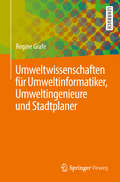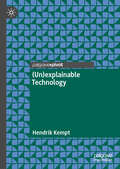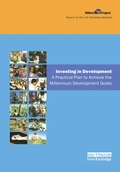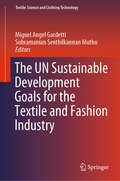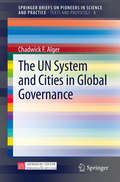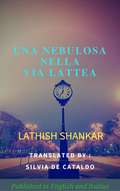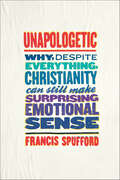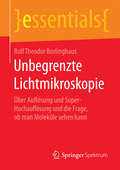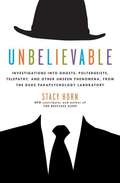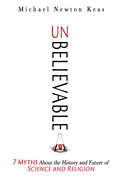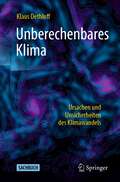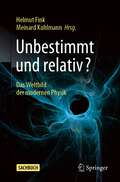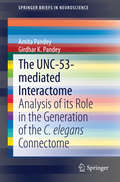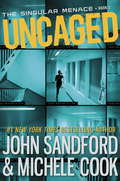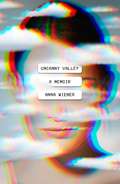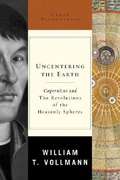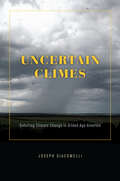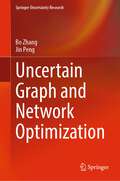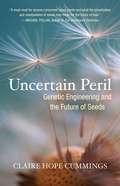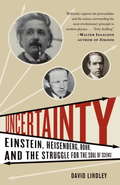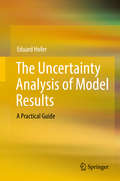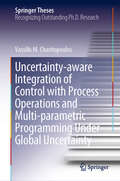- Table View
- List View
Umweltwissenschaften für Umweltinformatiker, Umweltingenieure und Stadtplaner
by Regine GrafeWas bedeutet umweltbezogene angewandte Informatik? Welche Bedeutung hat sie für die Wirtschaft und den Einzelnen? Wie ermittelt man praxisbezogene Daten im umwelttechnischen Bereich? Auf all diese Fragen finden Sie die Antworten sachgerecht, praxisnah und praxistauglich in diesem Buch. Wichtige Themen, vom notwendigen Basiswissen über die Stoffe und ihre Verbindungen, über physikalische Stressoren und biogene Komponenten bis hin zum Wissen über Informationssysteme und praxisbezogene rechtliche Grundlagen, sind hier klar strukturiert zusammengefasst. Die Vielzahl von Verweisen ermöglicht das Erkennen von umwelt- und gesundheitsbelastenden Zusammenhängen. Jedes einzelne Kapitel wird durch eine Zusammenfassung sowie Fragen zur Wiederholung vervollständigt. Die Perspektive der Autorin erlaubt einen Blick auf die Wechselbeziehungen unseres wirtschaftlichen Systems und zeigt, wie man sie untersuchen kann. Für die Datenerfassung werden umweltanalytische und Monitoring-Verfahren vorgestellt. Der manchmal abstrakte Inhalt wird dem Leser mit Hilfe von 120 Abbildungen veranschaulicht und schafft so die Brücke und das Verständnis zwischen umweltrelevanten Fakten mit Informatik-Tools. Besonderes Augenmerk legt die Autorin auf die Umweltkompartimente und erläutert die schädlichen Beeinflussungen sehr praxisnah. Umweltinformatikern, Umweltwissenschaftlern, Stadtplanern und Ingenieuren, sowie allen interessierten Laien bietet dieses Buch eine gute Einführung.
(Un)explainable Technology
by Hendrik KemptThis book explores the issue of (un)explainable technology. As we face technologies, mostly autonomous, machine-learned algorithms (AI) that elude a seamless explanation on how they work (“black boxes”), several issues both from an epistemological as well as ethical perspectives emerge. It is thus not surprising that there are plenty of technological attempts in illuminating the black box as well as philosophical efforts in conceptualizing and re- assessing our concepts of an explanation and understanding, as well emerging ethical questions on how to deal with this unexplainable technology. This book thus offers a succinct and comprehensive, opinionated but fair view on the emerging ethical debate on explainability of AI and its relevance for using AI for different more or less sensitive decision-making procedures. As a short book, the goal is to introduce the reader to the issues at hand while also offering normative arguments from different sides that motivate, complicate, and resolve these issues.
UN Millennium Development Library: A Practical Plan to Achieve the Millennium Development Goals
by Jeffrey D. Sachs The UN ProjectThis book describes the importance of the millennium development goals and gives an explanation of the progress toward the goals. It provides recommendations to be implemented at the country level and presents a guide for the international system's support for the country-level processes.
The UN Sustainable Development Goals for the Textile and Fashion Industry (Textile Science and Clothing Technology)
by Miguel Angel Gardetti Subramanian Senthilkannan MuthuThis book highlights the Sustainable Development Goals (SDGs) as part of the 2030 Agenda for Sustainable Development. These universally agreed-upon aspirational goals for people, the planet, prosperity, and peace will not be achieved without all global and local actors – governments, the private sector, and civil society – playing their part. The SDGs offer a unique opportunity to align existing sustainability initiatives through a common framework and accelerate the industry’s efforts to address important challenges in the global textile value chain. Future sourcing models will largely be redefined by how this sector addresses the underlying themes as sourcing countries prioritize the goals and integrate them into their national plans. Stimulating discussion and exploring the many different ways in which the textile and clothing industry can implement the UN SDGs, this informative book provides readers with a comprehensive understanding of the topic, and presents various approaches, including reflexive, empirical, hands-on or applied theoretical.
The UN System and Cities in Global Governance
by Chadwick F. AlgerThis is the second volume to commemorate the 90th birthday of the distinguished scholar Chadwick F. Alger to honor his lifetime achievement in international relations and as President of the International Studies Association (1978-1979). After a brief introduction by Chad F. Alger this volume presents six of his key texts on The UN System and Cities in Global Governance, focusing on "Cities as arenas for participatory learning in global citizenship"; "The Impact of Cities on International Systems"; "Perceiving, Analysing and Coping With the Local-Global Nexus"; "The World Relations of Cities: Closing the Gap Between Social Science Paradigms and Everyday Human Experience"; "Japanese Municipal International Exchange and Cooperation in the Asia-Pacific: Opportunities and Challenges" and on "Searching for Democratic Potential in Emerging Global Governance: What Are the Implications of Regional and Global Involvements of Local Governments?".
Una Nebulosa nella Via Lattea
by Lathish Shankar Silvia De CataldoPiù che un romanzo è uno stimolante racconto che narra di un viaggio nel tempo e che offre numerosi spunti di riflessione sul nostro rapporto con noi stessi e coloro che ci circondano.
Unapologetic: Why, Despite Everything, Christianity Can Still Make Surprising Emotional Sense
by Francis SpuffordFrancis Spufford's Unapologetic is a wonderfully pugnacious defense of Christianity. Refuting critics such as Richard Dawkins, Sam Harris, and the "new atheist" crowd, Spufford, a former atheist and Fellow of the Royal Society of Literature, argues that Christianity is recognizable, drawing on the deep and deeply ordinary vocabulary of human feeling, satisfying those who believe in it by offering a ruthlessly realistic account of the grown-up dignity of Christian experience.Fans of C. S. Lewis, N. T. Wright, Marilynne Robinson, Mary Karr, Diana Butler Bass, Rob Bell, and James Martin will appreciate Spufford's crisp, lively, and abashedly defiant thesis.Unapologetic is a book for believers who are fed up with being patronized, for non-believers curious about how faith can possibly work in the twenty-first century, and for anyone who feels there is something indefinably wrong, literalistic, anti-imaginative and intolerant about the way the atheist case is now being made.
Unbegrenzte Lichtmikroskopie: Über Auflösung und Super-Hochauflösung und die Frage, ob man Moleküle sehen kann (essentials)
by Rolf Theodor BorlinghausRolf T. Borlinghaus erläutert die Ursachen für die klassische Begrenzung der Lichtmikroskopie und beleuchtet die neuen Super-Hochauflösungstechniken. Dies ist besonders aktuell, da der Nobelpreis 2014 für Chemie für die Entwicklung von Technologien vergeben wurde, die es nun ermöglichen, mit Lichtmikroskopen feinere Details aufzulösen, als es die klassische Theorie einschränkend vorhersagt. Diese neuen Methoden stellen aber nicht das bisherige Weltbild der Optik in Frage, vielmehr nutzen sie ganz andere Phänomene, um mittels klassischer Optik Positionsbestimmungen von Molekülen durchzuführen. Das ist theoretisch beliebig genau möglich.
Unbelievable
by Stacy HornFrom The Sixth Sense to Medium, Ghost Whisperer to Ghost Hunters, the paranormal stirs heated debate, spawning millions of believers and skeptics alike. Nearly half of us say we believe in ghosts, and two-thirds of us believe in life after death. What would you make of rain barrels that refill themselves? Psychic horses? Mind-reading Cold War spies? For a group of scientists at the Duke Parapsychology Lab under the leadership of Dr. J. B. Rhine-considered the Einstein of the paranormal-such mysteries demanded further investigation. From 1930 to 1980, these dedicated men and women attempted to test the bizarre, the frightening, and the unexplainable against the rigors of science, ultimately finding proof that the human mind possesses telepathic powers.
Unbelievable: 7 Myths About the History and Future of Science and Religion
by Michael Newton KeasUnbelievable explodes seven of the most popular and pernicious myths about science and religion. Michael Newton Keas, a historian of science, lays out the facts to show how far the conventional wisdom departs from reality. He also shows how these myths have proliferated over the past four centuries and exert so much influence today, infiltrating science textbooks and popular culture. The seven myths, Keas shows, amount to little more than religion bashing—especially Christianity bashing.Unbelievable reveals: · Why the “Dark Ages” never happened · Why we didn’t need Christopher Columbus to prove the earth was round · Why Copernicus would be shocked to learn that he supposedly demoted humans from the center of the universe · What everyone gets wrong about Galileo’s clash with the Church, and why it matters today · Why the vastness of the universe does not deal a blow to religious belief in human significance · How the popular account of Giordano Bruno as a “martyr for science” ignores the fact that he was executed for theological reasons, not scientific ones · How a new myth is being positioned to replace religion—a futuristic myth that sounds scientific but isn’t In debunking these myths, Keas shows that the real history is much more interesting than the common narrative of religion at war with science. This accessible and entertaining book offers an invaluable resource to students, scholars, teachers, homeschoolers, and religious believers tired of being portrayed as anti-intellectual and anti-science.
Unberechenbares Klima: Ursachen und Unsicherheiten des Klimawandels
by Klaus DethloffDie Veränderungen unseres Klimas sind allgegenwärtig spürbar, das allgemeine Verständnis der Prozesse dahinter aber mit Informationen überschwemmt und vielfach gefiltert. Es fehlt ein tieferer Blick, um Klarheit über die beteiligten Prozesse zu erhalten und nicht zuletzt eigene Handlungsräume zu erkennen. Dieses Buch präsentiert den ungeschminkten Stand des Wissens und Nichtwissens zu den komplexen Ursachen des Klimawandels auf der Basis von globalen Datensätzen und Modellsimulationen. Nicht erschrecken – Der Anspruch besteht darin zu vereinfachen, ohne zu verfälschen. Klimaänderungen werden nicht nur durch Strahlungsprozesse, sondern auch die nichtlineare Dynamik des Atmosphäre-Meereis-Ozeansystems bestimmt. Die Dynamik des Planeten befindet sich nur teilweise in unserer Hand, denn neben dem menschlichen Einfluss durch Treibhausgase und Aerosole generiert das Klimasystem seine eigene interne Variabilität. Die globale Reduktion des Ausstoßes schädlicher Treibhausgase ist eine unerlässliche Maßnahme in allen Strategien zur Bewältigung des Klimawandels. Aber bleibt dessen Begrenzung ein unerfüllter Wunsch? Ein Buch, das von einem international ausgewiesenem Experten in der Arktisforschung geschrieben wurde, und komplexe Sachverhalte unseres Klimasystems für jeden interessierten Leser – den Naturwissenschaftler und den Laien - aufschlüsselt. Und das mit dem klaren Ziel aufzuzeigen, dass der Klimawandel nicht aufgehalten, sondern maximal in dessen Auswirkung auf unsere Lebenswelt begrenzt werden kann.
Unbestimmt und relativ?: Das Weltbild der modernen Physik
by Helmut Fink Meinard KuhlmannQuantentheorie und Relativitätstheorie haben das Weltbild der Physik revolutioniert. Beide Theorien gelten jedoch als unanschaulich und schwer verständlich. Dieses Sachbuch schafft neue Zugänge und lädt zum Mitdenken ein. Renommierte Experten aus Physik und Philosophie erläutern Grundbegriffe, Erkenntnisfortschritte und Deutungsfragen zu Raum, Zeit und Materie.Dabei kommen typische Themen aus der Philosophie der Physik zur Sprache, wie etwa die Interpretationsdebatte der Quantentheorie oder Modellbildungen in der Kosmologie. Weltbildrelevante Fragen nach dem Verhältnis von Mathematik, Empirie und Anschauung oder nach der Verlässlichkeit physikalischer Erkenntnis erfordern die Verbindung von Physik und Philosophie, von fachwissenschaftlicher Grundlagenforschung und methodenkritischer Reflexion. Der thematische Bogen geht zurück auf ein hochkarätig besetztes Symposium mit populärwissenschaftlicher Ausrichtung. Das Buch enthält Beiträge von Andreas Bartels, Robert Harlander, Paul Hoyningen-Huene, Gert-Ludwig Ingold, Claus Kiefer, Meinard Kuhlmann, Klaus Mainzer, Oliver Passon, Manfred Stöckler, Rüdiger Vaas und Reinhard Werner.
Unbiased Stereology: A Concise Guide
by Peter R. MoutonThis update to Peter R. Mouton’s pioneering work provides bioscientists with the concepts needed in order to apply the principles and practices of unbiased stereology to research involving biological tissues.Mouton starts with a brief explanation of the history and theory of the process before defining the terms, concepts, and tools of unbiased stereological procedures. He compares and contrasts the procedures with less-exacting approaches to quantitative analysis of biological structure using specific examples from biomedical literature. The book incorporates existing best practices with new methodologies, such as the Rare Event Protocol, while simplifying the dense, often difficult literature on the subject to show the utility and importance of unbiased stereology. This clear, insightful guide goes a step further than other books on this subject by demonstrating not only how to use unbiased stereology but also how to interpret and present the results.Written by the official U.S. representative to the International Society for Stereology, this is the most complete, up-to-date resource on the science of unbiased stereology. Those new to bioscience research as well as experienced practitioners will find that Mouton’s explanations are the perfect companion for stereology courses and workshops.
Unbound: How Eight Technologies Made Us Human and Brought Our World to the Brink
by Richard L. CurrierAlthough we usually think of technology as something unique to modern times, our ancestors began to create the first technologies millions of years ago in the form of prehistoric tools and weapons. Over time, eight key technologies gradually freed us from the limitations of our animal origins. The fabrication of weapons, the mastery of fire, and the technologies of clothing and shelter radically restructured the human body, enabling us to walk upright, shed our body hair, and migrate out of tropical Africa. Symbolic communication transformed human evolution from a slow biological process into a fast cultural process. The invention of agriculture revolutionized the relationship between humanity and the environment, and the technologies of interaction led to the birth of civilization. Precision machinery spawned the industrial revolution and the rise of nation-states; and in the next metamorphosis, digital technologies may well unite all of humanity for the benefit of future generations. Synthesizing the findings of primatology, paleontology, archeology, history, and anthropology, Richard Currier reinterprets and retells the modern narrative of human evolution that began with the discovery of Lucy and other Australopithecus fossils. But the same forces that allowed us to integrate technology into every aspect of our daily lives have also brought us to the brink of planetary catastrophe. Unbound explains both how we got here and how human society must be transformed again to achieve a sustainable future. Technology: "The deliberate modification of any natural object or substance with forethought to achieve a specific end or to serve a specific purpose. ”
The UNC-53-mediated Interactome
by Amita Pandey Girdhar K. PandeyThis book gives an overview of various interactomes involved in dorsal ventral (DV) and anterior posterior (AP) guidance, their mechanisms of action, subcellular localizations, and functional roles. It will provide readers a better understanding of the development of the nervous system, which in turn will help to find cures to various neural and other disorders. In nematodes there are two types of guidance systems, including DV and AP guidance. The signaling process that guides the growth cones along the DV axis has remained intact in both vertebrates and invertebrates. The adaptor protein UNC-53 appears to play a part in migration along the AP axis in both worms and their human homologs. "Neuron Navigators" (NAV) are also involved in nervous system development
Uncaged (The Singular Menace, #1)
by John Sandford Michele Cook#1 New York Times bestselling Prey author John Sandford and Michele Cook debut a high-octane young adult thriller series. Shay Remby arrives in Hollywood with $58 and a handmade knife, searching for her brother, Odin. Odin's a brilliant hacker but a bit of a loose cannon. He and a group of radical animal-rights activists hit a Singular Corp. research lab in Eugene, Oregon. The raid was a disaster, but Odin escaped with a set of highly encrypted flash drives and a post-surgical dog. When Shay gets a frantic 3 a.m. phone call from Odin--talking about evidence of unspeakable experiments, and a ruthless corporation, and how he must hide--she's concerned. When she gets a menacing visit from Singular's security team, she knows: her brother's a dead man walking. What Singular doesn't know--yet--is that 16-year-old Shay is every bit as ruthless as their security force, and she will burn Singular to the ground, if that's what it takes to save her brother.
Uncanny Valley: A Memoir
by Anna WienerThe prescient, page-turning account of a journey in Silicon Valley: a defining memoir of our digital age <P><P>In her mid-twenties, at the height of tech industry idealism, Anna Wiener—stuck, broke, and looking for meaning in her work, like any good millennial--left a job in book publishing for the promise of the new digital economy. She moved from New York to San Francisco, where she landed at a big-data startup in the heart of the Silicon Valley bubble: a world of surreal extravagance, dubious success, and fresh-faced entrepreneurs hell-bent on domination, glory, and, of course, progress. <P><P>Anna arrived amidst a massive cultural shift, as the tech industry rapidly transformed into a locus of wealth and power rivaling Wall Street. But amid the company ski vacations and in-office speakeasies, boyish camaraderie and ride-or-die corporate fealty, a new Silicon Valley began to emerge: one in far over its head, one that enriched itself at the expense of the idyllic future it claimed to be building. Part coming-of-age-story, part portrait of an already-bygone era, Anna Wiener’s memoir is a rare first-person glimpse into high-flying, reckless startup culture at a time of unchecked ambition, unregulated surveillance, wild fortune, and accelerating political power. With wit, candor, and heart, Anna deftly charts the tech industry’s shift from self-appointed world savior to democracy-endangering liability, alongside a personal narrative of aspiration, ambivalence, and disillusionment. <P><P>Unsparing and incisive, Uncanny Valley is a cautionary tale, and a revelatory interrogation of a world reckoning with consequences its unwitting designers are only beginning to understand.
Uncentering the Earth: Copernicus and the Revolutions of the Heavenly Spheres
by William T. VollmanOne of the books in a series called Great Discoveries, which presents good science in the clearest possible way.
Uncertain Climes: Debating Climate Change in Gilded Age America
by Joseph GiacomelliUncertain Climes looks to the late nineteenth century to reveal how climate anxiety was a crucial element in the emergence of American modernity. Even people who still refuse to accept the reality of human-induced climate change would have to agree that the topic has become inescapable in the United States in recent decades. But as Joseph Giacomelli shows in Uncertain Climes, this is actually nothing new: as far back as Gilded Age America, climate uncertainty has infused major debates on economic growth and national development. In this ambitious examination of late-nineteenth-century understandings of climate, Giacomelli draws on the work of scientists, foresters, surveyors, and settlers to demonstrate how central the subject was to the emergence of American modernity. Amid constant concerns about volatile weather patterns and the use of natural resources, nineteenth-century Americans developed a multilayered discourse on climate and what it might mean for the nation’s future. Although climate science was still in its nascent stages during the Gilded Age, fears and hopes about climate change animated the overarching political struggles of the time, including expansion into the American West. Giacomelli makes clear that uncertainty was the common theme linking concerns about human-induced climate change with cultural worries about the sustainability of capitalist expansionism in an era remarkably similar to the United States’ unsettled present.
Uncertain Graph and Network Optimization (Springer Uncertainty Research)
by Bo Zhang Jin PengThis first book focuses on uncertain graph and network optimization. It covers three different main contents: uncertain graph, uncertain programming and uncertain network optimization. It also presents applications of uncertain network optimization in a lot of real problems such as transportation problems, dispatching medical supplies problems and location problems.The book is suitable for researchers, engineers, teachers and students in the field of mathematics, information science, computer science, decision science, management science and engineering, artificial intelligence, industrial engineering, economics and operations research.
Uncertain Peril: Genetic Engineering and the Future of Seeds
by Claire Hope CummingsAfter serving as an environmental lawyer for 20 years, four of them with the US Department of Agriculture, Cummings is now a writer and broadcast reporter based in rural northern California. Here she presents a cautionary account of genetic engineering as it is being used in agriculture, though she suggests that many of her findings could apply to its use in medicine, biological warfare, and other areas as well. Her topics include trade secrets, the ownership society, the botany of scarcity, and a conversation with corn. Annotation ©2008 Book News, Inc. , Portland, OR (booknews. com)
Uncertainty: Einstein, Heisenberg, Bohr, and the Struggle for the Soul of Science
by David LindleyThe more precisely the position is determined, the less precisely the momentum is known in this instant, and vice versa. --Werner Heisenberg <P> That God would choose to play dice with the world is something I cannot believe. --Albert Einstein <P> Nothing exists until it is measured. --Neils Bohr <P> The remarkable story of a startling scientific idea that ignited a battle among the greatest minds of the twentieth century and profoundly influenced intellectual inquiry in fields ranging from physics to literary criticism, anthropology and journalism In 1927, the young German physicist Werner Heisenberg challenged centuries of scientific understanding when he introduced what came to be known as "the uncertainty principle. " Building on his own radical innovations in quantum theory, Heisenberg proved that in many physical measurements, you can obtain one bit of information only at the price of losing another. Heisenberg's principle implied that scientific quantities/concepts do not have absolute, independent meaning, but acquire meaning only in terms of the experiments used to measure them. This proposition, undermining the cherished belief that science could reveal the physical world with limitless detail and precision, placed Heisenberg in direct opposition to the revered Albert Einstein. The eminent scientist Niels Bohr, Heisenberg's mentor and Einstein's long-time friend, found himself caught between the two. Uncertaintychronicles the birth and evolution of one of the most significant findings in the history of science, and portrays the clash of ideas and personalities it provoked. Einstein was emotionally as well as intellectually determined to prove the uncertainty principle false. Heisenberg represented a new generation of physicists who believed that quantum theory overthrew the old certainties; confident of his reasoning, Heisenberg dismissed Einstein's objections. Bohr understood that Heisenberg was correct, but he also recognized the vital necessity of gaining Einstein's support as the world faced the shocking implications of Heisenberg's principle.
Uncertainty Analyses in Environmental Sciences and Hydrogeology: Methods and Applications to Subsurface Contamination (SpringerBriefs in Applied Sciences and Technology)
by Rachid Ababou Juliette Chastanet Jean-Marie Côme Manuel Marcoux Michel QuintardThis book highlights several methods and quantitative implementations of both probabilistic and fuzzy-based approaches to uncertainty quantification and uncertainty propagation through environmental subsurface pollution models with uncertain input parameters. The book focuses on methods as well as applications in hydrogeology, soil hydrology, groundwater contamination, and related areas (e.g., corrosion of nuclear waste canisters). The methods are illustrated for a broad spectrum of models, from non-differential I/O models to complex PDE solvers, including a novel 3D quasi-analytical model of contaminant transport, and a site-specific computer model of dissolved contaminant migration from a DNAPL (Dense Non Aqueous Phase Liquid) pollution source.
The Uncertainty Analysis of Model Results: A Practical Guide
by Eduard HoferThis book is a practical guide to the uncertainty analysis of computer model applications. Used in many areas, such as engineering, ecology and economics, computer models are subject to various uncertainties at the level of model formulations, parameter values and input data. Naturally, it would be advantageous to know the combined effect of these uncertainties on the model results as well as whether the state of knowledge should be improved in order to reduce the uncertainty of the results most effectively. The book supports decision-makers, model developers and users in their argumentation for an uncertainty analysis and assists them in the interpretation of the analysis results.
Uncertainty-aware Integration of Control with Process Operations and Multi-parametric Programming Under Global Uncertainty (Springer Theses)
by Vassilis M. CharitopoulosThis book introduces models and methodologies that can be employed towards making the Industry 4.0 vision a reality within the process industries, and at the same time investigates the impact of uncertainties in such highly integrated settings. Advances in computing power along with the widespread availability of data have led process industries to consider a new paradigm for automated and more efficient operations. The book presents a theoretically proven optimal solution to multi-parametric linear and mixed-integer linear programs and efficient solutions to problems such as process scheduling and design under global uncertainty. It also proposes a systematic framework for the uncertainty-aware integration of planning, scheduling and control, based on the judicious coupling of reactive and proactive methods. Using these developments, the book demonstrates how the integration of different decision-making layers and their simultaneous optimisation can enhance industrial process operations and their economic resilience in the face of uncertainty.
